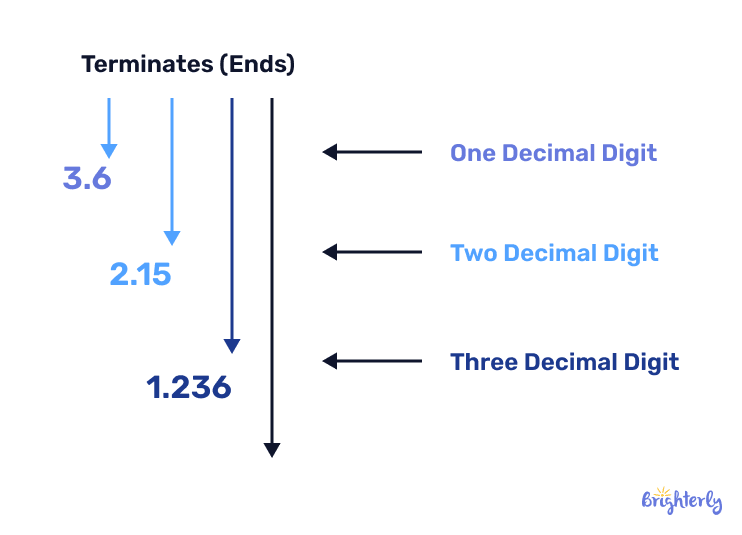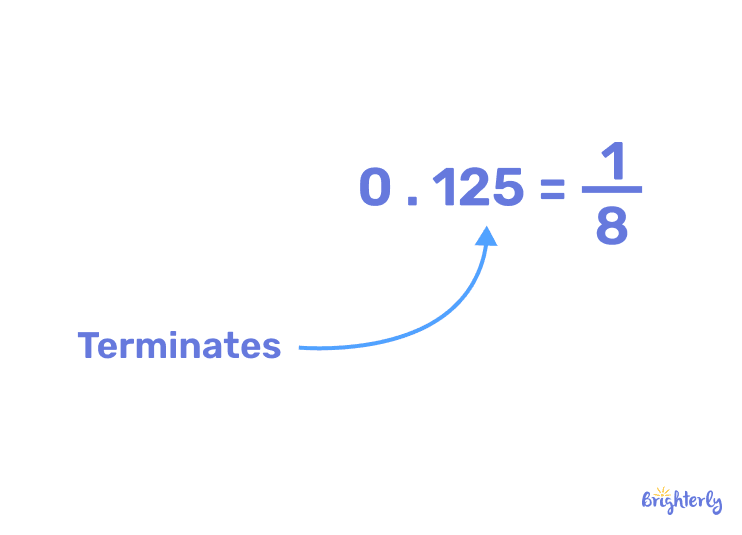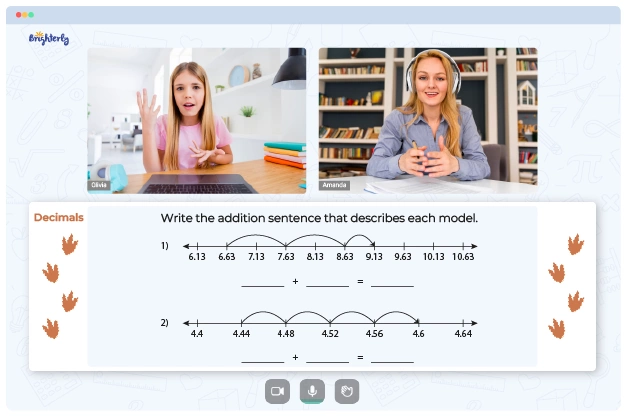Terminating Decimals – Definition, Theorem, Examples
Updated on November 27, 2025
When it comes to learning about numbers and improving your number sense, decimals are a key piece of that puzzle. But did you know there are different types of decimals? One of the types you’ll encounter frequently is the terminating decimal. This type of decimal ends after a certain number of digits — aka, they are definite and not indefinite or recurring.
In this article, we’ll define terminating decimal and cover how to recognise them as well as delve into various theorems aimed to simplify your work with them. We’ll also share practice problems with you so you can test your brand-new expertise!
What is a terminating decimal?
The terminating decimal meaning is a number that ends after a finite number of digits — aka, it terminates. So if you’re asking, “What is a decimal that terminates?” it’s a number whose decimal expansion does not go on infinitely, and the final decimal place is not recurring. The decimal 1.54 is an example of terminating decimal because it ends after the hundredths place.
Because all terminating decimals are rational numbers, they can also be written in the form of fractions. So, in our above example, 1.54 becomes 154/100, which can be simplified to 77/50.

How to recognize a terminating decimal?
It’s pretty easy to recognize a terminating decimal. All you need to do is look out for its final, or terminating digit. A number like 0.238 is a terminating decimal because it ends after the thousandths place. However, if we look at decimals like 0.3333 ̇, which represents ⅓, we can see that it is not terminating because the 3 repeats forever (and is denoted by the small dot).
Terminating decimals examples
There are an infinite number of terminating decimals examples. That’s because terminating decimals can have many place value digits, but they will always come to a finite end. Some examples of terminating decimals include:
- 0.5
- 1.42
- 8.893201
- 23.395
- 150.1389
How to identify a terminating decimal
To identify a terminating decimal, you can check if it has a final digit, in which case it is terminating and finite. However, if you have your decimal presented as a fraction, there are ways you can identify if it’s terminating or not.
- First, you’d simplify your fraction.
- Next, you’d factor your denominator.
- Finally, check your prime factors — if they are only 2 or 5, then your decimal is terminating. If they have factors other than 2 or 5, however, they will be recurring or indefinite.

Theorems on terminating decimals
There is a key theorem on terminating decimals that, when put into practice, can help us work with them more easily.
You saw an example of that theorem above when we explained how to identify a terminating decimal using its fraction counterpart! The method of identifying if a decimal is terminating by simplifying fractions and factoring the denominator represents our theorem, which states that a fraction in its simplest form must have prime factors of 2 or 5 to be a decimal that terminates.
What is a non terminating decimal?
A non-terminating decimal is a number with decimal digits that go on infinitely. This can either be a recurring decimal like 0.6666 ̇, which represents the fraction of ⅔, or a defined number like pi (𝛑), which goes on infinitely.
A recurring decimal is also known as a repeating decimal, while a non-recurring, non-terminating decimal is known as a non-repeating decimal.
Facts about terminating decimals
Terminating decimals are a fascinating topic, so you won’t be surprised to learn that they entail lots of interesting facts! Here are just a few:
- All terminating decimals can also be expressed as fractions
- Every terminal decimal will also be a rational number — but not every rational number is a terminating decimal
- Decimals that are non-repeating and non-terminating (like pi) are known as irrational numbers
Solved examples on terminating decimals
Here, we’ve provided you with questions on terminating decimals, their answers, and a guide to how we solved them.
Solved math task 1
You have the fraction ⅝. Is this a terminating decimal?
Answer
| Yes. |
This is because the fraction is in its simplest form, and all prime factors of the denominator are 2 or 5.
When simplified, 5/8 equals 0.625, which is a terminating decimal.
Solved math task 2
You have the fraction 7/9. Is this a terminating decimal?
Answer
| No, because the denominator 9 does not have the prime factors of 2 or 5. When simplified, 7/9 equals 0.7777, which is a repeating decimal. |
Practice problems on terminating decimals
Now it’s your turn! We’ve told you the terminating decimal definition with example and shared ready-made problems. Use this knowledge to solve the problems below.
- You have the fraction 3/16. Is this a terminating decimal?
- You have the fraction 2/11. Is this a decimal that terminates?
- What is the fraction 4/5 expressed as a terminating decimal?
Conclusion
Here, we’ve covered the terminating decimal definition and answered questions like “Are terminating decimals rational?” and “How do I identify a terminating decimal?” Armed with this toolkit, you’ll be able to solve any problem with terminating decimals now!
Frequently asked questions on terminating decimals
What is a terminating decimal?
A terminating decimal is a decimal number that has a finite stopping point. A terminating decimal example is 0.1398 because it ends at the ten-thousandths place. Decimals that are never-ending are non-terminating.
What does terminating mean in math?
Terminating means numbers have a finite end in math. This usually relates to decimals, which can carry on infinitely, but a terminating decimal has a defined endpoint.
Are all terminating decimals rational numbers?
Yes, all terminating decimals are rational numbers. A rational number is a number that can be expressed as a fraction with integers as numerators and denominators, and a denominator that is not zero, and this is true of terminating decimals.
What are examples of terminating decimals?
Some examples of terminating decimals include:
- 2.1983
- 3.4
- 7.82
- 14.5






